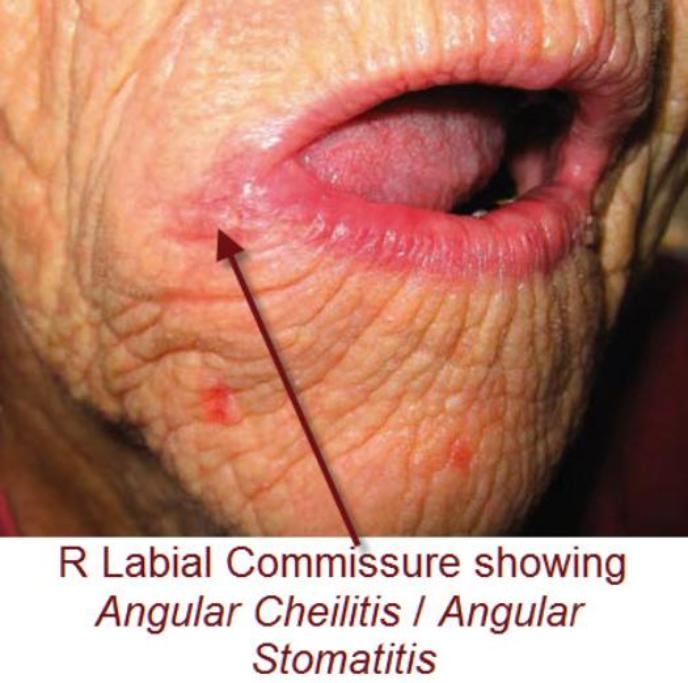Angular Cheilitis / Angular Stomatitis
What is Angular Cheilitis?
Angular Cheilitis (AC) is inflammation at the commissures (angles) of the lips.
Angular Cheilitis (also called Perlèche, Cheilosis or Angular Stomatitis) is an inflammatory lesion at the labial commissures (corner of the mouth) and often occurs bilaterally (both sides). The condition manifests as deep cracks or splits; in severe cases, the splits can bleed when the mouth is opened and shallow ulcers or a crust may form.
What are the signs & symptoms?
Soreness, erythema (redness) and fissuring (cracking) affect the angles of the mouth symmetrically. Angular cheilitis most commonly presents as roughly triangular areas of erythema and œdema (swelling) at both commissures. Atrophy, ulceration, crusting, maceration and scaling may be seen. A burning sensation and a feeling of dryness may occur. An eczematous dermatitis may extend some distance onto the cheek or chin as an infective eczematoid reaction or as a reaction to topical medicaments.
In long-standing lesions, suppuration and granulation tissue may develop.
Lesions occasionally extend beyond the vermilion border onto the skin in the form of linear furrows or fissures radiating from the angle of the mouth (rhagades), mainly in the more severe forms, especially in denture wearers.
Commonly, there is also associated denture-related stomatitis. Rarely, there is also commissural leukoplakia intra-orally.
This is usually a clinical diagnosis, made by clinical examination alone.
Angular cheilitis accompanied by alopecia, diarrhoea and non-specific oral ulcerations, most commonly of the tongue and buccal mucosa, may suggest zinc deficiency.
What are the causes of Angular Cheilitis?
Predisposing Factors
AC is predisposed by what are known as the ‘3Ds’.
Denture-wearing and disorders that predispose to Candidiasis:
- dry mouth
- tobacco smoking.
Deficiency states such as:
- iron deficiency
- hypovitaminoses (especially B)
- mal-absorption states (e.g. Crohn’s disease)
- possibly zinc deficiency (rarely) defects in immunity such as in Down syndrome, HIV infection, diabetes, cancer and others.
Disorders where the lips are enlarged, such as oro-facial granulomatosis, Crohn’s disease and Down syndrome.
A number of factors (infective, mechanical, nutritional or immunological) may be implicated alone or in combination. AC is most often chronic, seen in the elderly and due to infective and / or mechanical causes.
- Infective agents are probably the major cause. Infective agents can be isolated in > 50% of lesions, with mainly Candida or staphylococci being isolated.
Candida albicans is the most commonly isolated and is typically carried in the saliva. Oral candidiasis causing cheilitis is particularly common in those wearing dentures, especially where there is denture-related stomatitis and was probably responsible for some cases of cheilitis attributed to allergy to denture materials – since contamination of denture-material by Candida may cause false-positive patch-test reactions. Dry mouth also predisposes to candidiasis.
Staphylococcus aureus and / or streptococci may also be cultured from lesions, and may be harboured in the nose (anterior nares).
- Mechanical factors may play a part in the œdentulous (toothless) patient who does not wear or who has inadequate dentures. As a consequence of ageing, the upper lip overhangs the lower at the angles of the mouth, producing a fold that keeps a small area of skin macerated. Maceration of the commissural epithelium can also be brought about by habitual licking as a nervous tic or by sucking on objects (perlèche). Few authors consider that the lesion results solely from maceration.
- Deficiencies of hæmatinics (factors required for blood formation – which include iron, vitamin B and folic acid) and deficiencies of immunity can lead to proliferation of Candida species.
- Nutritional deficiencies, in particular, deficiencies of riboflavin, folate, iron, zinc and general protein malnutrition, have been incriminated in AC but are rare. AC is, very occasionally, an isolated initial sign of anæmia or vitamin deficiency, such as vitamin B12 deficiency; more often there is also oral ulceration and glossitis.
- Immune deficiency such as in diabetes, Down syndrome or HIV disease may result in AC associated with candidiasis.
In uncommon conditions where the lips are enlarged, such as Oro-Facial Granulomatosis, up to 20% of individuals have angular stomatitis, although Candida species are not often isolated.
How is it treated?
Management of AC is sometimes difficult and may need to be prolonged.
- Tobacco habits should be stopped.
- Eliminate any underlying systemic pre-disposing factors. Underlying systemic disease must be sought and treated and a course of oral iron and vitamin B supplements may be helpful in indolent cases.
- The skin lesions should be swabbed (to see if there is an infective element to the condition).
- If infection is the cause of AC, treatment will only be effective if the underlying disease process is also being treated.
- Permanent cure can be achieved only by eliminating candidiasis as well as the growth of Candida beneath the denture. Recurrence of AC must be prevented by eliminating organisms from their reservoir (that is, the denture); treatment of the denture is with a topical anti-fungal (e.g. miconazole).
- Staphylococcus infection can be cleared with topical antibiotics such as fusidic acid ointment or cream used at least four times daily.
- Mixed infections of Candida and Staphylococcus respond best to topical miconazole.
- Mechanical predisposing factors should be corrected. A change in dentures may be necessary; new dentures which restore facial contour may help.
- In rare intractable cases, surgery or, occasionally, collagen injections may be useful in trying to restore normal commissural anatomy.
Useful Articles & Websites
American Association of Family Practitioners
Primary Care Dermatology Society
Canadian Family Physician 2007. Dermacase Answer. 3. Angular Cheilitis
Ind J Dent Res 2017. Angular Cheilitis – A Clinical & Microbial Study
StatPearls 20019. Angular Cheilitis
Proceedings 2019. Photodynamic Therapy in Non-Responsive Oral Angular Cheilitis – 4 Case Reports


